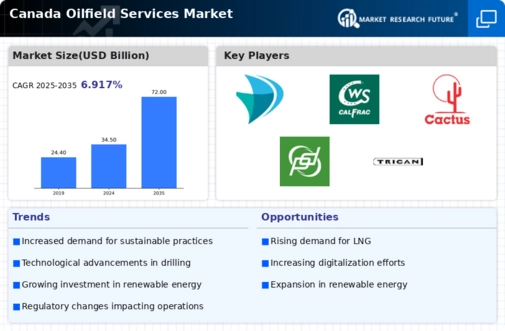Enhanced Regulatory Frameworks
Enhanced regulatory frameworks are influencing the oilfield services market in Canada. The government is implementing stricter environmental regulations and safety standards to ensure sustainable practices within the industry. In 2025, compliance with these regulations is expected to drive up operational costs by approximately 10%, prompting companies to seek more efficient service providers. This regulatory environment encourages innovation and the adoption of best practices, as firms strive to meet compliance requirements while minimizing their environmental footprint. Consequently, the oilfield services market is likely to see a shift towards more sustainable practices, which could enhance the reputation of the industry and attract investment.
Increased Exploration Activities
The oilfield services market in Canada is currently experiencing a surge in exploration activities, driven by rising crude oil prices and the need for energy security. As companies seek to discover new reserves, the demand for drilling services, geological surveys, and related technologies is likely to increase. In 2025, the Canadian Association of Petroleum Producers reported that exploration spending could reach approximately $3 billion, reflecting a 15% increase from the previous year. This uptick in exploration not only stimulates the oilfield services market but also creates job opportunities and boosts local economies. Furthermore, advancements in seismic imaging and data analytics are enhancing exploration efficiency, making it a pivotal driver in the oilfield services market.
Investment in Infrastructure Development
Investment in infrastructure development is a crucial driver for the oilfield services market in Canada. The government and private sector are increasingly allocating funds to enhance transportation networks, pipelines, and processing facilities. In 2025, it is estimated that infrastructure investments could exceed $10 billion, facilitating the efficient movement of oil and gas products. This investment not only supports existing operations but also encourages new projects, thereby increasing the demand for oilfield services. Enhanced infrastructure is essential for reducing bottlenecks and improving supply chain efficiency, which is vital for the competitiveness of the oilfield services market. As infrastructure projects progress, they are expected to create numerous job opportunities, further stimulating economic growth.
Technological Integration and Innovation
Technological integration and innovation are transforming the oilfield services market in Canada. Companies are increasingly adopting advanced technologies such as artificial intelligence, machine learning, and automation to optimize operations and reduce costs. In 2025, it is projected that investments in technology could account for up to 25% of total operational expenditures in the oilfield services market. This shift towards digitalization not only enhances efficiency but also improves safety and environmental compliance. Moreover, the integration of real-time data analytics allows for better decision-making and resource management, which is essential in a competitive market. As firms continue to innovate, the oilfield services market is likely to witness significant growth driven by these technological advancements.
Growing Demand for Energy Transition Solutions
The growing demand for energy transition solutions is reshaping the oilfield services market in Canada. As the country aims to reduce greenhouse gas emissions and transition towards cleaner energy sources, there is an increasing need for services that support this shift. In 2025, it is anticipated that investments in renewable energy projects could reach $5 billion, creating opportunities for oilfield service providers to diversify their offerings. This trend may lead to the development of hybrid solutions that combine traditional oil and gas services with renewable energy technologies. Consequently, the oilfield services market is likely to evolve, adapting to the changing energy landscape while maintaining its relevance in a more sustainable future.
















Leave a Comment